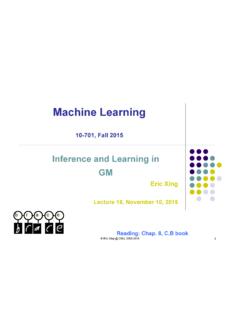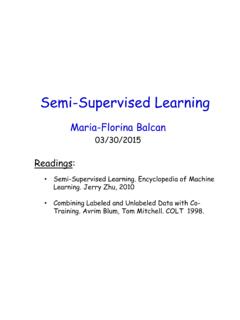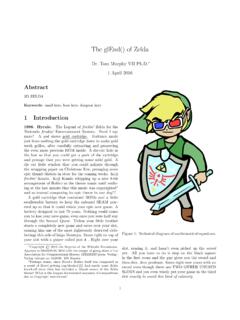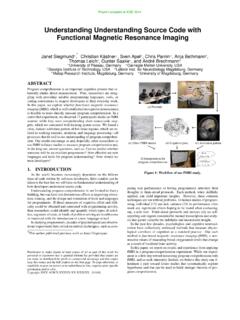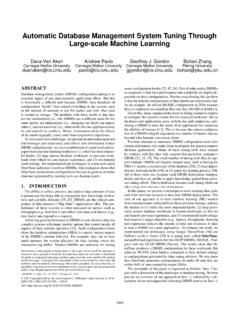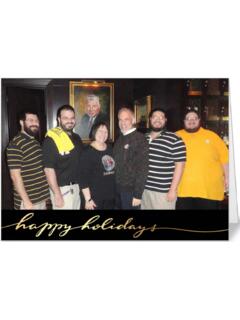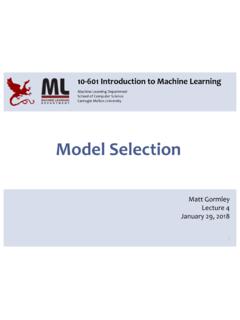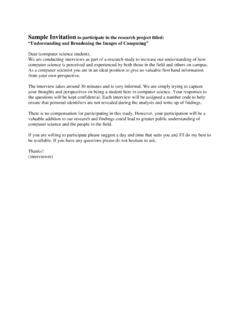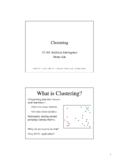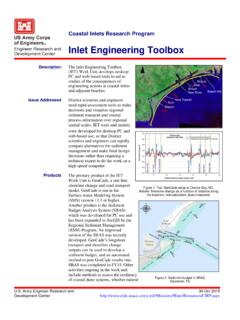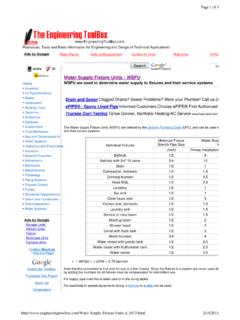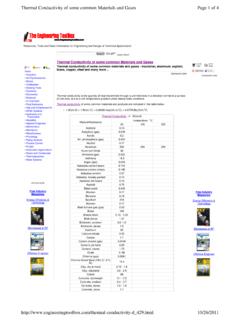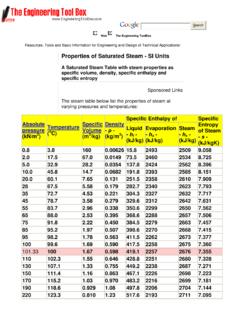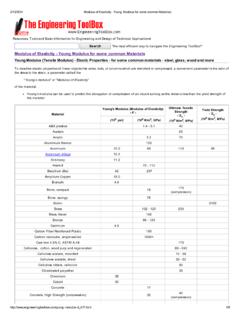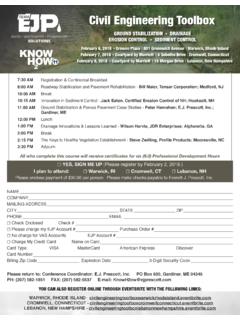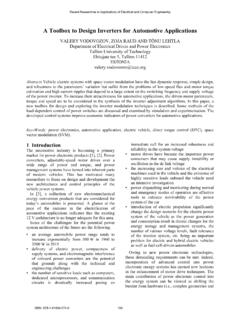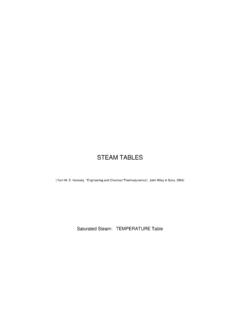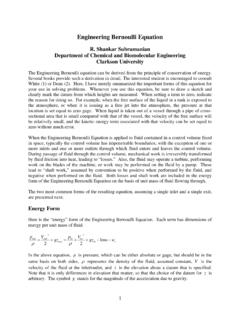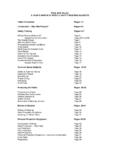Transcription of An Engineering Toolbox to Build Situation Aware Ambient ...
1 An Engineering Toolbox to Build Situation Aware Ambient assisted LivingSystemsWerner Kurschl, Stefan Mitsch and Johannes SchoenboeckUpper Austria University of Applied SciencesResearch Center HagenbergDepartment of Software EngineeringSoftwarepark 11, A-4232 Hagenberg, Austria{kurschl, smitsch, to increasing anticipated average life and health ex-penditure Ambient assisted living (AAL) systems attract theattention of researchers. To successfully Build and deployAAL systems knowledge from different fields of computerscience is needed: pervasive computing to gain the rawdata, machine learning and pattern recognition to interpretthese data and HCI knowledge to allow implicit interactionwith the this paper we propose a reference architecture forbuilding AAL systems.}
2 Based on this reference architec-ture we introduce a Toolbox that simplifies the developmentof AAL systems. The Toolbox consists of a meta-model forpipeline systems, a low-level context model, high-level con-text ontologies, customizable components and tool IntroductionRoutine medical check-ups often needed by elderly,handicapped, or otherwise needy people in hospitals or atthe local doctor pose significant effort on both, the patientand the medical staff. Moreover, these check-ups are just asnapshot of the patient s physical constitution, because col-lecting continuous data would be too costly in terms of timeand money. Additionally, patients often have to stay at hos-pitals just for the purpose of monitoring their well-being andto do some routine check-ups ( , after a medical treat-ment or a surgery).
3 If such patients could leave hospitalsearlier and do these routine check-ups themselves at home,the medical staff would be effectively unburdened from rou-tine work, while at the same time the medical care qualitycould be enhanced by continuous monitoring ([22] also em-phasizes the importance of continuous monitoring).To reach these goals we envision Ambient assisted liv-ing (AAL) systems that consist of various hardware andsoftware components integrated into everyday items orworn/used by patients. The collected information could beevaluated either by medical staff or by an AAL system for irregularities, alarming changes, or symptoms. The sys-tem could even automatically alert relatives, care givers,ormedical staff (taking into account a regulatory frameworkfor processing medical data as well as privacy protection).
4 Another aspect of an AAL system is to improve elderlyand needy persons habitability: it should assist them in liv-ing autonomously, and let them participate in social com-munities and family life. Envisioned living assistants in-clude item tracking and searching, warning of householddangers ( , slippery floor, unattended stove, or runningwater taps), and recognition of alarming situations ( ,collapse, sleep disorders). Social applications include com-munication, entertainment, and awareness displays ( ,neighbor at home, or family emotions).To recognize these situations sensors integrated withinthe living environment are needed. To date hardware sen-sors and software components that can provide or interpretsome of the data needed already exist. But a common in-frastructure to integrate these components has yet to be de-veloped.
5 AAL systems require a stable and profound ar-chitecture, which enables the seamless integration of differ-ent sensor types to acquire quantitative raw data. A situa-tion inference engine transforms quantitative low-level con-text into qualitative high-level context data ( , situations).These situations are the basis to reason about possible ac-tions ( , update a display, switch an actuator, or call theambulance).In this paper we present a reference architecture for AALsystems and propose a development Toolbox to simplify theimplementation of such systems using a Model Driven Soft-ware Development (MDSD) AAL System Reference ArchitectureBaldauf et al. compare in [4] various architectures intheir survey on context- Aware systems: (i) direct sensoraccess applications tightly integrate sensor access and ap-plication, which is useful for small, stand-alone applica-tions, (ii) middleware-based applications use layers to sep-arate low-level sensor details from application details, and(iii) context-server applications additionally permit multipleclients to access shared context data on a applications, mainly used for distributedsystems, are most flexible because heterogeneous clientsand sensors can be integrated.
6 Additionally, resource-intensive operations can be transferred from power-restricted sensors to a server. SOCAM (see [14]) and JCAF(see [6]) are examples of context-server applications. [2]and [31] describe how a layered architecture can separatedetecting and using context to improve extensibility 1 shows the reference architecture we usethroughout this paper (based on the described work). Westructure the architecture into three main tiers accordingtoa typical deployment s hardware boundaries. Within eachtier an n-layer ( , data layer, business layer, and presen-tation layer) design might prove Processing TierContext Application TierHealthVisualizationAmbient DisplaysSituation Awareness, Semantic Reasoning (Rules, Predictions, etc.), ActionsSituation InferenceData StoreKnowledge SharingContext Sensing TierSensor AbstractionWearable SensorsTinyOS MotesEIBH ealth SensorsPositionsSituationsUser PreferencesTracing InformationRaw Sensor DataFeaturesLow-Level ContextData StoreActuatorsAcquisitionLayerRepresen-t ation LayerAggre-gation LayerInterpre-tationLayerUtilizationLaye rApplicationLayerInferenceLayerSemantic LayerData LayerPhysicalLayercf.
7 Zhangcf. AilistoFigure 1. AAL System Reference Architecturewith Layers according to [31] and [2] The Context Sensing TierAmbient assisted living applications often need differenttypes of measurements or sensor values ( , sound, ac-celeration, water flow, light) from the surrounding environ-ment, which are usually provided by sensors and processingboards from different manufacturers. To ease the integra-tion of these sensors a sensor abstraction layer is necessary,which uses common plug-in software patterns for sensor-specific implementation parts. The data provided by thesensor abstraction layer is furthermore described in termsof a common data model, thereby hiding sensor-specific is-sues within the sensor abstraction The Context Processing TierThe context processing tier provides persistent storagefor context data.
8 Moreover it derives high-level context(situations) from low-level context (raw context data fromthe sensors) using feature extraction, machine learning, andpattern recognition algorithms. These high-level contextdata, if described in terms of an ontology, are the founda-tion for Situation awareness as defined by [12]. Reasoningon situations permits to assess situations and predict futuredevelopments ( Situation evolution). The Context Application TierThe context application tier contains applications thatutilize context information to adjust their behavior. Differ-ent applications might listen to events of the reasoning en-gine including explicit and implicit systems as mentionedin [21]. Explicit interaction systems always require a kindof dialog between the user and a particular system or com-puter.
9 Especially for AAL systems implicit human inter-action should be taken into consideration. Schmidt definesimplicit human-computer interactions as interaction of a hu-man with the environment and with artifacts aiming to ac-complish a goal. The output of implicit systems should beseamlessly integrated with the environment of the user. [13]proposes to use Ambient displays that operate at the periph-ery of a user s attention ( , some artwork).Furthermore different types of actuators could be con-sumers of events of the reasoning engine. Knowledge shar-ing with other systems ( , medical information systems)may also be implemented Development Toolbox ArchitectureTo support the development of AAL applications that ad-here to the reference architecture described above, we pro-pose a development Toolbox , which consists of a meta-model for pipeline systems, a low-level context model, high-level context ontologies, customizable components (sensor abstraction, featureextraction, classifier learning algorithms, etc.)
10 And modeling and development toolsfor each of the three application tiers. The Toolbox shouldassist developers in the following activities: software de-velopment for (i) sensing devices, (ii) the data processingparts, and (iii) data analysis and classification to Meta-Model for Pipeline SystemsFor implementing the context processing tier the tool-box provides components for feature extraction, supervisedclassifier learning, and unsupervised clustering (all fromthefield of machine learning and pattern classification). Theprocessing of raw data, which is typically provided by sen-sors as data stream, is done in a processing chain (see designpattern Tee-and-Join-Pipeline-System in [11]).ContextRecognizerContextComponentF ilterReaderClassifierWriterPortInPortOut PortDataPacketConnectionCompositeCompone ntFigure 2.
